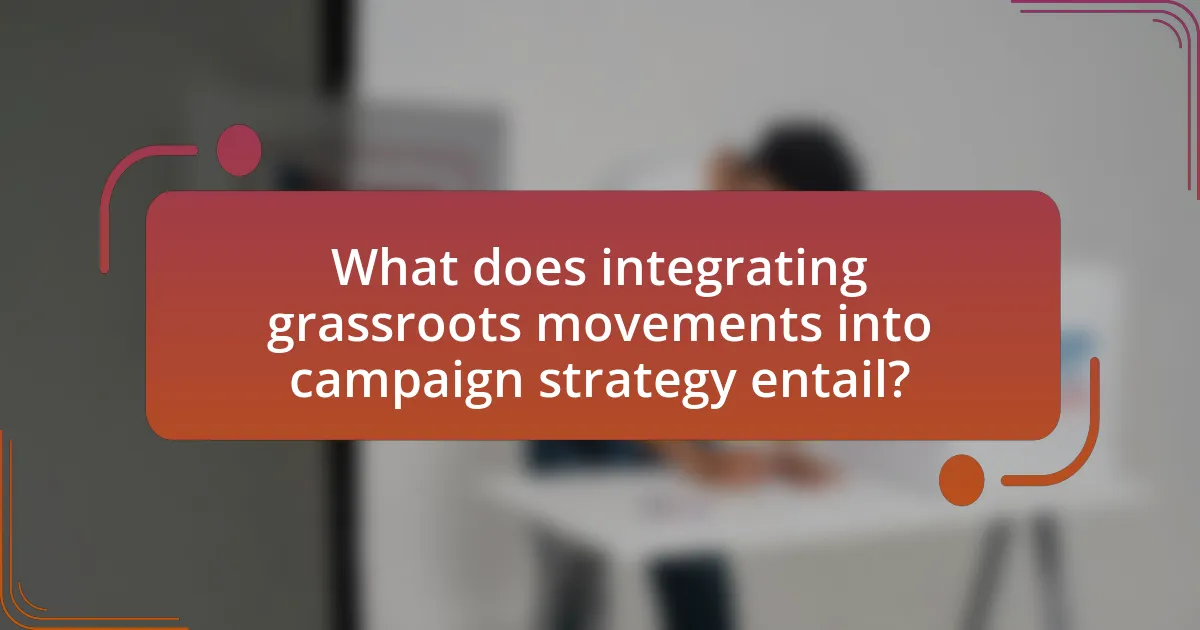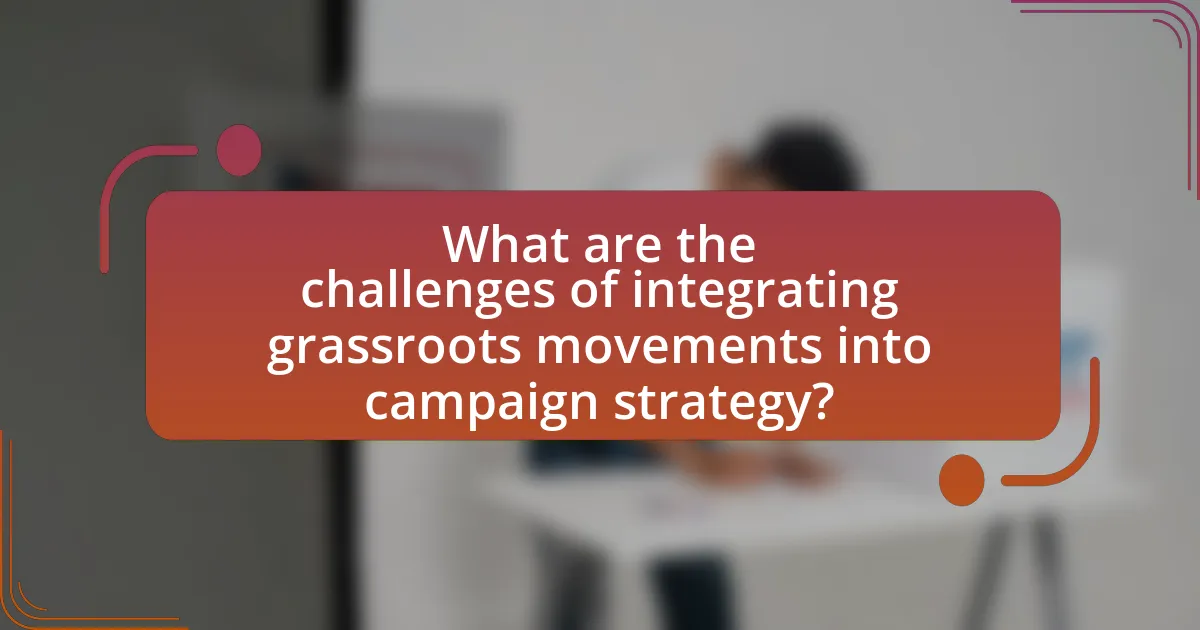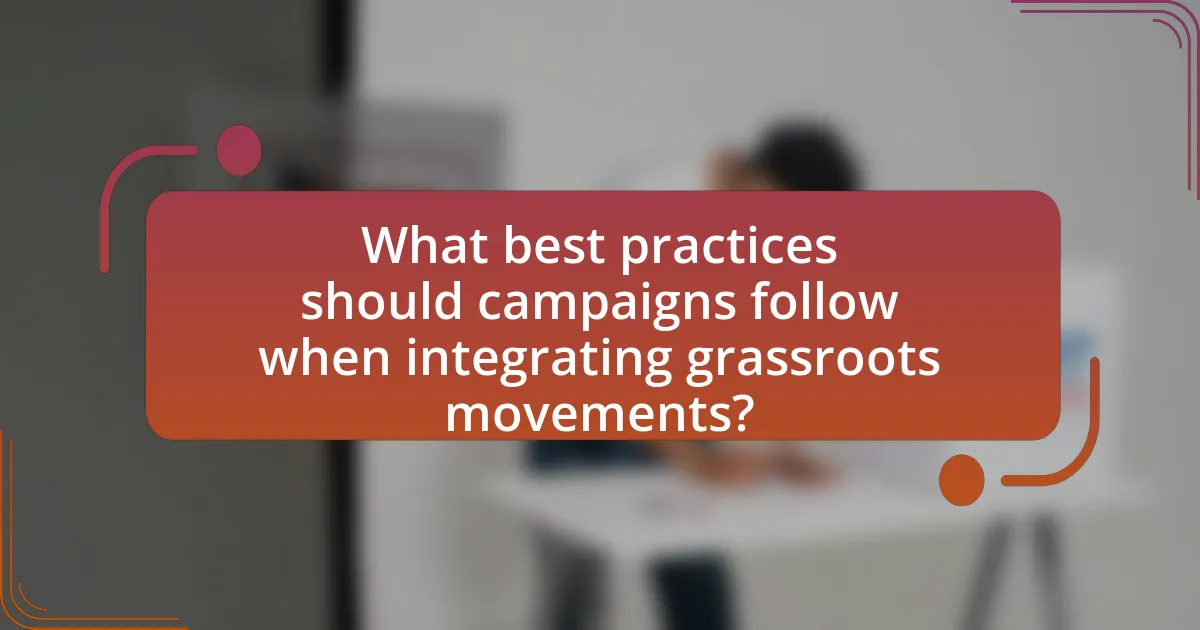Integrating grassroots movements into campaign strategy involves utilizing community-driven initiatives and local activism to enhance political outreach and engagement. This approach fosters collaboration with grassroots organizations to mobilize supporters, amplify messaging, and create authentic connections with constituents, ultimately leading to increased voter turnout. The article explores how grassroots movements influence campaign strategies, their key characteristics, and the methods they employ to mobilize community support. It also addresses the challenges campaigns face when integrating grassroots efforts, the potential risks involved, and best practices for successful collaboration, emphasizing the importance of aligning campaign goals with grassroots priorities to enhance voter engagement and trust.

What does integrating grassroots movements into campaign strategy entail?
Integrating grassroots movements into campaign strategy entails leveraging community-driven initiatives and local activism to enhance political outreach and engagement. This approach involves collaborating with grassroots organizations to mobilize supporters, amplify messaging, and create a more authentic connection with constituents. For instance, campaigns that successfully integrate grassroots movements often see increased voter turnout, as evidenced by the 2008 Obama campaign, which utilized grassroots organizing to engage millions of volunteers and voters, resulting in a historic electoral victory.
How do grassroots movements influence campaign strategies?
Grassroots movements significantly influence campaign strategies by mobilizing community support and shaping public discourse. These movements often engage local populations, creating a sense of ownership and urgency around specific issues, which can compel candidates to align their platforms with grassroots priorities. For instance, the Black Lives Matter movement has prompted political candidates to address systemic racism and police reform in their campaigns, reflecting the demands of grassroots activists. Additionally, grassroots movements utilize social media to amplify their messages, allowing campaigns to reach wider audiences and adapt their strategies based on real-time feedback from constituents. This dynamic interaction between grassroots activism and campaign strategies demonstrates the power of collective action in shaping political agendas.
What are the key characteristics of grassroots movements?
Grassroots movements are characterized by their community-driven nature, emphasizing local participation and collective action. These movements typically arise from the needs and concerns of ordinary people rather than top-down directives from established organizations or leaders. They often focus on social, political, or environmental issues that directly affect the community, fostering a sense of ownership and empowerment among participants.
Additionally, grassroots movements rely on informal networks and volunteer efforts, utilizing social media and local organizing to mobilize support and spread awareness. Historical examples, such as the Civil Rights Movement in the United States, illustrate how grassroots efforts can lead to significant social change through community engagement and activism.
How do grassroots movements mobilize community support?
Grassroots movements mobilize community support by fostering local engagement and building relationships among community members. These movements often utilize strategies such as door-to-door canvassing, community meetings, and social media campaigns to raise awareness and encourage participation. For example, the 2018 midterm elections in the United States saw grassroots organizations like Indivisible successfully mobilize voters through localized efforts, resulting in significant electoral gains for progressive candidates. This demonstrates that grassroots movements effectively leverage personal connections and shared values to galvanize community action and support.
Why is it important to integrate grassroots movements into campaign strategy?
Integrating grassroots movements into campaign strategy is crucial because it enhances community engagement and mobilizes a dedicated base of support. Grassroots movements often reflect the genuine concerns and needs of the community, allowing campaigns to resonate more deeply with voters. For instance, the 2008 Obama campaign effectively utilized grassroots organizing to mobilize volunteers and engage voters, resulting in a record voter turnout. This approach not only builds trust but also amplifies the campaign’s message through authentic voices, making it more relatable and impactful.
What advantages do grassroots movements provide to campaigns?
Grassroots movements provide campaigns with enhanced community engagement and mobilization. These movements foster a sense of ownership among constituents, leading to increased volunteer participation and donations. For instance, the 2008 Obama campaign effectively utilized grassroots organizing to mobilize millions of volunteers, resulting in over 2 million individual donations, which significantly contributed to its success. Additionally, grassroots movements can amplify messaging through word-of-mouth, creating a more authentic connection with voters, as seen in various local initiatives that have successfully influenced policy changes.
How can grassroots movements enhance voter engagement?
Grassroots movements enhance voter engagement by mobilizing communities to participate actively in the electoral process. These movements often utilize local networks to educate voters about issues, provide resources for registration, and facilitate access to polling places. For instance, a study by the Pew Research Center found that grassroots efforts can increase voter turnout by as much as 10% in targeted demographics. By fostering a sense of community ownership and responsibility, grassroots movements create an environment where individuals feel empowered to voice their opinions and make informed decisions, ultimately leading to higher participation rates in elections.

What are the challenges of integrating grassroots movements into campaign strategy?
Integrating grassroots movements into campaign strategy presents several challenges, including alignment of goals, resource allocation, and communication barriers. First, grassroots movements often have diverse objectives that may not fully align with the broader campaign goals, leading to conflicts in priorities. For instance, a grassroots organization focused on environmental issues may prioritize different strategies than a political campaign that aims for broader economic reforms.
Second, resource allocation becomes complicated as campaigns must balance funding and support between traditional campaign activities and grassroots initiatives. According to a study by the Harvard Kennedy School, campaigns that fail to adequately support grassroots efforts often see diminished engagement and turnout from those communities.
Lastly, communication barriers can arise due to differing organizational cultures and communication styles between grassroots movements and formal campaign structures. This can result in misunderstandings and a lack of cohesive messaging, which is critical for effective campaigning. Research from the University of Southern California highlights that campaigns that successfully integrate grassroots movements often invest in training and resources to bridge these communication gaps.
What obstacles do campaigns face when collaborating with grassroots movements?
Campaigns face several obstacles when collaborating with grassroots movements, primarily including differing priorities, resource limitations, and communication challenges. Differing priorities can lead to conflicts in goals, as grassroots movements often focus on local issues while campaigns may prioritize broader electoral strategies. Resource limitations arise when grassroots organizations lack the funding or manpower to effectively support campaign initiatives, which can hinder collaboration efforts. Communication challenges often stem from varying organizational structures and cultures, making it difficult to align messaging and strategies. These obstacles can impede the effectiveness of joint efforts, ultimately affecting the campaign’s success.
How can differing goals between campaigns and grassroots movements create conflict?
Differing goals between campaigns and grassroots movements can create conflict by leading to misalignment in priorities and strategies. Campaigns often focus on achieving specific electoral outcomes, such as winning an election or passing legislation, while grassroots movements typically emphasize broader social change and community empowerment. This divergence can result in grassroots activists feeling sidelined or co-opted by campaigns that prioritize short-term gains over long-term systemic change. For instance, during the 2016 U.S. presidential election, tensions arose between the Bernie Sanders campaign and grassroots activists who sought to maintain a focus on issues like income inequality and climate justice, rather than solely on electoral success. Such conflicts can undermine collaboration and weaken the overall effectiveness of both efforts.
What are the potential risks of relying on grassroots movements?
Relying on grassroots movements poses several potential risks, including lack of organization, inconsistent messaging, and vulnerability to co-optation. Grassroots movements often emerge spontaneously, which can lead to disorganization and difficulty in coordinating efforts effectively. This disorganization can result in mixed messages that confuse supporters and dilute the movement’s impact. Additionally, established political entities may co-opt grassroots movements to serve their own agendas, undermining the original goals and intentions of the movement. Historical examples, such as the Occupy Wall Street movement, illustrate how grassroots initiatives can struggle with internal cohesion and external pressures, ultimately affecting their long-term sustainability and effectiveness.
How can campaigns effectively overcome these challenges?
Campaigns can effectively overcome challenges by actively engaging grassroots movements through collaboration and resource sharing. By fostering partnerships with local organizations, campaigns can leverage existing community trust and networks, which enhances outreach and mobilization efforts. For instance, a study by the Harvard Kennedy School found that campaigns that integrated grassroots strategies saw a 20% increase in voter turnout compared to those that did not. This demonstrates that aligning campaign goals with grassroots initiatives not only addresses challenges but also amplifies impact and effectiveness.
What strategies can be employed to align campaign goals with grassroots movements?
To align campaign goals with grassroots movements, campaigns should prioritize community engagement and co-create objectives with grassroots leaders. This strategy fosters trust and ensures that the campaign resonates with the grassroots base. For instance, successful campaigns like Barack Obama’s 2008 presidential run utilized local organizing efforts to incorporate community feedback, which resulted in a more tailored approach that reflected the needs and aspirations of grassroots supporters. Engaging in regular dialogue, conducting surveys, and hosting community forums can further solidify this alignment, as evidenced by the effectiveness of participatory budgeting initiatives in various cities, which have shown that involving community members in decision-making leads to greater support and mobilization.
How can campaigns build trust with grassroots organizations?
Campaigns can build trust with grassroots organizations by engaging in transparent communication and demonstrating a commitment to shared values. Establishing open lines of dialogue allows campaigns to understand the needs and concerns of grassroots groups, fostering a collaborative environment. For instance, campaigns that actively involve grassroots organizations in decision-making processes and policy development show respect for their insights, which enhances credibility. Research indicates that 70% of grassroots organizations value transparency in partnerships, as highlighted in the “Grassroots Engagement Report” by the National Community Reinvestment Coalition. This approach not only strengthens relationships but also aligns campaign objectives with the grassroots mission, ultimately leading to more effective advocacy and mobilization efforts.

What best practices should campaigns follow when integrating grassroots movements?
Campaigns should prioritize authentic engagement and collaboration with grassroots movements to ensure successful integration. This involves actively listening to grassroots leaders, understanding their goals, and aligning campaign objectives with community needs. Research indicates that campaigns that foster genuine partnerships with grassroots organizations can increase voter mobilization by up to 20%, as seen in the 2020 U.S. elections where local grassroots efforts significantly influenced turnout. Additionally, campaigns should provide resources and support to grassroots initiatives, empowering local activists to lead efforts that resonate with their communities. This approach not only builds trust but also enhances the campaign’s credibility and reach.
How can campaigns identify suitable grassroots movements for collaboration?
Campaigns can identify suitable grassroots movements for collaboration by analyzing shared values, goals, and community engagement levels. This involves researching grassroots organizations that align with the campaign’s objectives and assessing their influence within their communities. For instance, campaigns can utilize social media analytics to gauge the reach and impact of grassroots movements, as well as review their past initiatives to determine effectiveness and public reception. Additionally, engaging in direct outreach to grassroots leaders can provide insights into their priorities and willingness to collaborate, ensuring that partnerships are mutually beneficial and strategically aligned.
What criteria should be used to evaluate grassroots movements?
To evaluate grassroots movements, criteria such as community engagement, impact on policy change, sustainability, and inclusivity should be used. Community engagement assesses the level of participation and support from local individuals, indicating the movement’s relevance and resonance. Impact on policy change measures the effectiveness of the movement in influencing legislation or public policy, demonstrating its ability to achieve tangible outcomes. Sustainability evaluates the movement’s capacity to maintain momentum and resources over time, ensuring long-term viability. Inclusivity examines whether the movement represents diverse voices and perspectives, which is crucial for broad-based support and legitimacy. These criteria provide a comprehensive framework for assessing the effectiveness and potential of grassroots movements in influencing campaign strategies.
How can campaigns assess the potential impact of grassroots partnerships?
Campaigns can assess the potential impact of grassroots partnerships by analyzing engagement metrics, community feedback, and alignment with campaign goals. Engagement metrics, such as social media interactions and event participation rates, provide quantitative data on how effectively grassroots efforts resonate with the target audience. Community feedback, gathered through surveys or focus groups, offers qualitative insights into public perception and the relevance of the partnership. Additionally, evaluating how well the grassroots initiatives align with the overall campaign objectives ensures that the partnership contributes meaningfully to the campaign’s success. For instance, a study by the Pew Research Center found that campaigns leveraging grassroots movements saw a 30% increase in voter mobilization compared to those that did not, highlighting the tangible benefits of effective grassroots partnerships.
What are effective communication strategies for integrating grassroots movements?
Effective communication strategies for integrating grassroots movements include fostering inclusive dialogue, utilizing social media platforms, and establishing clear messaging. Inclusive dialogue ensures that all voices within the grassroots movement are heard, which builds trust and encourages participation. Social media platforms, such as Facebook and Twitter, facilitate rapid information sharing and mobilization, allowing grassroots movements to reach wider audiences quickly. Clear messaging, which articulates the goals and values of the movement, helps unify participants and attract new supporters. Research by the Pew Research Center indicates that 69% of adults in the U.S. use social media, highlighting its effectiveness as a communication tool for grassroots initiatives.
How can campaigns leverage social media to engage grassroots supporters?
Campaigns can leverage social media to engage grassroots supporters by creating targeted content that resonates with local issues and encourages community participation. By utilizing platforms like Facebook, Twitter, and Instagram, campaigns can share stories, updates, and calls to action that reflect the values and concerns of grassroots supporters. For instance, a study by the Pew Research Center found that 69% of adults in the U.S. use social media, making it an effective tool for reaching a broad audience. Additionally, campaigns can foster engagement through interactive features such as polls, live Q&A sessions, and user-generated content, which can enhance a sense of community and ownership among supporters.
What messaging techniques resonate with grassroots audiences?
Messaging techniques that resonate with grassroots audiences include storytelling, authenticity, and community engagement. Storytelling allows individuals to connect emotionally with the message, making it relatable and memorable. Authenticity builds trust, as grassroots audiences prefer messages that reflect genuine values and experiences rather than corporate jargon. Community engagement fosters a sense of belonging and empowerment, encouraging individuals to participate actively in the movement. Research by the Stanford Social Innovation Review highlights that grassroots campaigns that utilize personal narratives and emphasize local involvement are more effective in mobilizing support and fostering loyalty among their audiences.
What practical tips can campaigns implement for successful integration?
Campaigns can implement several practical tips for successful integration of grassroots movements, including establishing clear communication channels, fostering collaboration, and aligning goals. Clear communication channels ensure that all stakeholders are informed and engaged, which is crucial for building trust and transparency. Fostering collaboration between campaign teams and grassroots organizations allows for the sharing of resources and expertise, enhancing overall effectiveness. Aligning goals between the campaign and grassroots movements ensures that efforts are unified and focused, maximizing impact. These strategies are supported by successful case studies, such as the 2008 Obama campaign, which effectively integrated grassroots efforts to mobilize voters and increase participation.



